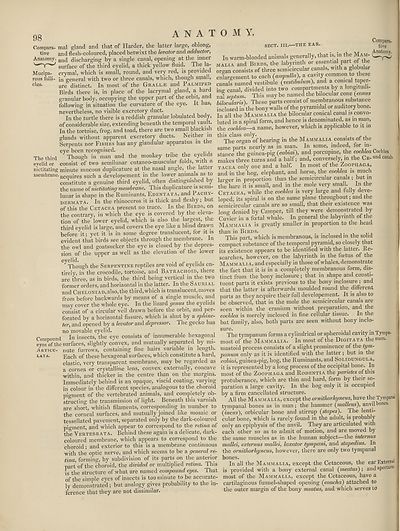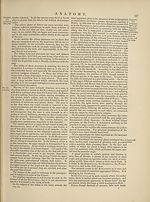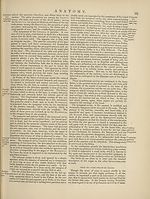Encyclopaedia Britannica > Volume 3, Anatomy-Astronomy
(106) Page 98
Download files
Complete book:
Individual page:
Thumbnail gallery: Grid view | List view

98
ANATOMY.
Compara- mal gland and that of Harder, the latter large, oblong,
tive and flesh-coloured, placed betwixt the levator and adductor,
Anatomy. ant\ discharging by a single canal, opening at the inner
surface of the third eyelid, a thick yellow fluid. The la-
SECT. III.—THE EAR.
Compara-
tive
In warm-blooded animals generally, that is, in the Mam-
MALIA and Birds, the labyrinth or essential part of the
Mucipa¬
rous folli¬
cles.
crymal, which is small, round, and very red, is provided organ consists of three sem'^cuaica > g
in general with two or three canals, which, though small, enlargement to each (aw^Za), a ca ty t
are distinct. In most of the Grall* and Palmiped canals named vestibule
Birds there is, in place of the lacrymal gland, a hard
granular body, occupying the upper part of the orbit, and
following in "situation the curvature of the eye. It has,
nevertheless, no visible excretory duct.
In the turtle there is a reddish granular lobulated body,
of considerable size, extending beneath the temporal vault.
In the tortoise, frog, and toad, there are two small blackish
glands without apparent excretory ducts. Neither in
Serpents nor Fishes has any glandular apparatus in the
eye been recognised.
The third Though in man and the monkey tribe the eyelids
eyelid or consist of two semilunar cutaneo-muscular folds, with a
nictitating minute mucous duplicature at the nasal angle, the latter
membrane. acqUires such a developement in the lower animals as to
constitute a genuine third eyelid, often distinguished by
the name of nictitating membrane. I his duplicature is semi-
canais nauicu ^ , • * j.
ing canal, divided into two compartments by a longitudi¬
nal septum. This may be named the bilocular cone (corcw
bilocularis). These parts consist of membranous substance
inclosed in the bony walls of the pyramidal or auditory bone.
In all the Mammalia the bilocular conical canal is convo¬
luted in a spiral form, and hence is denominated, as in man,
the cochlea—a name, however, which is applicable to it in
this class only. . ,
The organ of hearing in the Mammalia consists of the
same parts nearly as in man. In some, indeed, f°r in-
dtnnce the euinea-pig (cabiai), and porcupine, the cochlea Cochlea
makes ftree turns and a half; and, conversely, in the Ce- and c*
TACEA only one and a half. In most of the Zoophaga,
and in the hog, elephant, and horse, the cochlea is much
laro-er in proportion than the semicircular canals ; but in
the hare it is small, and in the mole very small. In the
of this the Cetacea present no trace. In the Birds, on
the contrary, in which the eye is covered by the eleva¬
tion of the lower eyelid, which is also the largest, the
third eyelid is large, and covers the eye like a blind drawn
before it; yet it is in some degree translucent, for it is
evident that birds see objects through the membrane. In
semicircular canals are so small, that their existence was
long denied by Camper, till they were demonstrated by
Cuvier in a foetal whale. In general the labyrinth of the
Mammalia is greatly smaller in proportion to the head
than in Birds. . . ..
This part, which is membranous, is inclosed in the solid
* n .1 . 1 : A 4-V»r»f
^T^rf«he«eTrdp™id.rdorlyA««
sion of the upper as well as the elevation of the lower ^ existence appears to be .dent.fied w.th the a .
eyelid.
Though the Serpentine reptiles are void of eyelids en¬
tirely, in the crocodile, tortoise, and Batrachoid, theie
are three, as in birds, the third being vertical in the two
former orders, and horizontal in the latter. In the Saurial
and Cheloniad, also, the third, which is translucent, moves
from before backwards by means of a single muscle, and
may cover the whole eye. In the lizard genus the eyelids
consist of a circular veil drawn before the orbit, and per¬
forated by a horizontal fissure, which is shut by a sphinc¬
ter, and opened by a levator and depressor. The gecko has
no movable eyelid.
Compound 1° insects, the eye consists of innumerable hexagonal
eyes of the surfaces, slightly convex, and mutually sepaiated by mi-
Articu- nute furrows, containing fine hairs variable, in length.
lata. Each of these hexagonal surfaces, which constitute a hard,
elastic, very transparent membrane, may be regarded as
a cornea or crystalline lens, convex externally, concave
within, and thicker in the centre than on the margins.
Immediately behind is an opaque, viscid coating, varying
in colour in the different species, analogous to the choroid
pigment of the vertebrated animals, and completely ob¬
structing the transmission of light. Beneath this varnish
are short, whitish filaments, corresponding in number to
the corneal surfaces, and mutually joined like mosaic or
tessellated pavement, separated only by the dark-coloured
pigment, and which appear to correspond to the retina of
the Vertebrata. Behind these again is a delicate, dark-
coloured membrane, which appears to correspond to the
choroid; and exterior to this is a membrane continuous
with the optic nerve, and which seems to be a general re¬
tina, forming, by subdivision of its parts on the anteiior
part of the choroid, the divided or multiplied retina. This
is the structure of what are named compound eyes. That
of the simple eyes of insects is too minute to be accurate¬
ly demonstrated; but analogy gives probability to the in¬
ference that they are not dissimilar.
searches, however, on the labyrinth in the foetus of the
Mammalia, and especially in those of whales, demonstrate
the fact that it is in a completely membranous form, dis¬
tinct from the bony inclosure; that in shape and consti¬
tuent parts it exists previous to the bony inclosure ; and
that the latter is afterwards moulded round the different
parts as they acquire their full developement. It is also to
be observed, that in the mole the semicircular canals are
seen within the cranium without preparation, and the
cochlea is merely inclosed in fine cellular tissue. In the
bat family, also, both parts are seen without bony inclo-
sure. . .
The tympanum forms a cylindrical or spheroidal cavity in Tympa.
most of the Mammalia. In most of the Digitata thenum*
mastoid process consists of a slight prominence of the tym¬
panum only as it is identified with the latter; but in the
cabiai, guinea-pig, hog, the Ruminants, and So.lidungula,
it is represented by a long process of the occipital bone. In
most of the Zoophaga and Rodentia the parietes of this
protuberance, which are thin and hard, form by their se¬
paration a large cavity. In the hog only it is occupied
by a firm cancellated structure.
All the Mammalia, except the ornithorhyncus, have the Tympanal
tympanal bones as in man; the hammer (malleus), anvil bones.
(incus), orbicular bone and stirrup (stapes). The lenti¬
cular bone, which is rarely found in the adult, is probably
only an epiphysis of the anvil. They are articulated with
each other so as to admit of motion, and are moved by
the same muscles as in the human subject—the internus
mallei, externus mallei, laxator tympani, and stapedius. In
the ornithorhyncus, however, there are only two tympanal
bones.
In all the Mammalia, except the Cetaceous, the ear Externa
is provided with a bony external canal (meatus)-, and3?611111’6,
most of the Mammalia, except the Cetaceous, have a
cartilaginous funnel-shaped opening (concha) attached to
the outer margin of the bony meatus, and which serves to
ANATOMY.
Compara- mal gland and that of Harder, the latter large, oblong,
tive and flesh-coloured, placed betwixt the levator and adductor,
Anatomy. ant\ discharging by a single canal, opening at the inner
surface of the third eyelid, a thick yellow fluid. The la-
SECT. III.—THE EAR.
Compara-
tive
In warm-blooded animals generally, that is, in the Mam-
MALIA and Birds, the labyrinth or essential part of the
Mucipa¬
rous folli¬
cles.
crymal, which is small, round, and very red, is provided organ consists of three sem'^cuaica > g
in general with two or three canals, which, though small, enlargement to each (aw^Za), a ca ty t
are distinct. In most of the Grall* and Palmiped canals named vestibule
Birds there is, in place of the lacrymal gland, a hard
granular body, occupying the upper part of the orbit, and
following in "situation the curvature of the eye. It has,
nevertheless, no visible excretory duct.
In the turtle there is a reddish granular lobulated body,
of considerable size, extending beneath the temporal vault.
In the tortoise, frog, and toad, there are two small blackish
glands without apparent excretory ducts. Neither in
Serpents nor Fishes has any glandular apparatus in the
eye been recognised.
The third Though in man and the monkey tribe the eyelids
eyelid or consist of two semilunar cutaneo-muscular folds, with a
nictitating minute mucous duplicature at the nasal angle, the latter
membrane. acqUires such a developement in the lower animals as to
constitute a genuine third eyelid, often distinguished by
the name of nictitating membrane. I his duplicature is semi-
canais nauicu ^ , • * j.
ing canal, divided into two compartments by a longitudi¬
nal septum. This may be named the bilocular cone (corcw
bilocularis). These parts consist of membranous substance
inclosed in the bony walls of the pyramidal or auditory bone.
In all the Mammalia the bilocular conical canal is convo¬
luted in a spiral form, and hence is denominated, as in man,
the cochlea—a name, however, which is applicable to it in
this class only. . ,
The organ of hearing in the Mammalia consists of the
same parts nearly as in man. In some, indeed, f°r in-
dtnnce the euinea-pig (cabiai), and porcupine, the cochlea Cochlea
makes ftree turns and a half; and, conversely, in the Ce- and c*
TACEA only one and a half. In most of the Zoophaga,
and in the hog, elephant, and horse, the cochlea is much
laro-er in proportion than the semicircular canals ; but in
the hare it is small, and in the mole very small. In the
of this the Cetacea present no trace. In the Birds, on
the contrary, in which the eye is covered by the eleva¬
tion of the lower eyelid, which is also the largest, the
third eyelid is large, and covers the eye like a blind drawn
before it; yet it is in some degree translucent, for it is
evident that birds see objects through the membrane. In
semicircular canals are so small, that their existence was
long denied by Camper, till they were demonstrated by
Cuvier in a foetal whale. In general the labyrinth of the
Mammalia is greatly smaller in proportion to the head
than in Birds. . . ..
This part, which is membranous, is inclosed in the solid
* n .1 . 1 : A 4-V»r»f
^T^rf«he«eTrdp™id.rdorlyA««
sion of the upper as well as the elevation of the lower ^ existence appears to be .dent.fied w.th the a .
eyelid.
Though the Serpentine reptiles are void of eyelids en¬
tirely, in the crocodile, tortoise, and Batrachoid, theie
are three, as in birds, the third being vertical in the two
former orders, and horizontal in the latter. In the Saurial
and Cheloniad, also, the third, which is translucent, moves
from before backwards by means of a single muscle, and
may cover the whole eye. In the lizard genus the eyelids
consist of a circular veil drawn before the orbit, and per¬
forated by a horizontal fissure, which is shut by a sphinc¬
ter, and opened by a levator and depressor. The gecko has
no movable eyelid.
Compound 1° insects, the eye consists of innumerable hexagonal
eyes of the surfaces, slightly convex, and mutually sepaiated by mi-
Articu- nute furrows, containing fine hairs variable, in length.
lata. Each of these hexagonal surfaces, which constitute a hard,
elastic, very transparent membrane, may be regarded as
a cornea or crystalline lens, convex externally, concave
within, and thicker in the centre than on the margins.
Immediately behind is an opaque, viscid coating, varying
in colour in the different species, analogous to the choroid
pigment of the vertebrated animals, and completely ob¬
structing the transmission of light. Beneath this varnish
are short, whitish filaments, corresponding in number to
the corneal surfaces, and mutually joined like mosaic or
tessellated pavement, separated only by the dark-coloured
pigment, and which appear to correspond to the retina of
the Vertebrata. Behind these again is a delicate, dark-
coloured membrane, which appears to correspond to the
choroid; and exterior to this is a membrane continuous
with the optic nerve, and which seems to be a general re¬
tina, forming, by subdivision of its parts on the anteiior
part of the choroid, the divided or multiplied retina. This
is the structure of what are named compound eyes. That
of the simple eyes of insects is too minute to be accurate¬
ly demonstrated; but analogy gives probability to the in¬
ference that they are not dissimilar.
searches, however, on the labyrinth in the foetus of the
Mammalia, and especially in those of whales, demonstrate
the fact that it is in a completely membranous form, dis¬
tinct from the bony inclosure; that in shape and consti¬
tuent parts it exists previous to the bony inclosure ; and
that the latter is afterwards moulded round the different
parts as they acquire their full developement. It is also to
be observed, that in the mole the semicircular canals are
seen within the cranium without preparation, and the
cochlea is merely inclosed in fine cellular tissue. In the
bat family, also, both parts are seen without bony inclo-
sure. . .
The tympanum forms a cylindrical or spheroidal cavity in Tympa.
most of the Mammalia. In most of the Digitata thenum*
mastoid process consists of a slight prominence of the tym¬
panum only as it is identified with the latter; but in the
cabiai, guinea-pig, hog, the Ruminants, and So.lidungula,
it is represented by a long process of the occipital bone. In
most of the Zoophaga and Rodentia the parietes of this
protuberance, which are thin and hard, form by their se¬
paration a large cavity. In the hog only it is occupied
by a firm cancellated structure.
All the Mammalia, except the ornithorhyncus, have the Tympanal
tympanal bones as in man; the hammer (malleus), anvil bones.
(incus), orbicular bone and stirrup (stapes). The lenti¬
cular bone, which is rarely found in the adult, is probably
only an epiphysis of the anvil. They are articulated with
each other so as to admit of motion, and are moved by
the same muscles as in the human subject—the internus
mallei, externus mallei, laxator tympani, and stapedius. In
the ornithorhyncus, however, there are only two tympanal
bones.
In all the Mammalia, except the Cetaceous, the ear Externa
is provided with a bony external canal (meatus)-, and3?611111’6,
most of the Mammalia, except the Cetaceous, have a
cartilaginous funnel-shaped opening (concha) attached to
the outer margin of the bony meatus, and which serves to
Set display mode to:
![]() Universal Viewer |
Universal Viewer | ![]() Mirador |
Large image | Transcription
Mirador |
Large image | Transcription
Images and transcriptions on this page, including medium image downloads, may be used under the Creative Commons Attribution 4.0 International Licence unless otherwise stated. ![]()
| Encyclopaedia Britannica > Encyclopaedia Britannica > Volume 3, Anatomy-Astronomy > (106) Page 98 |
|---|
| Permanent URL | https://digital.nls.uk/193758726 |
|---|
| Attribution and copyright: |
|
|---|---|
| Shelfmark | EB.16 |
|---|---|
| Description | Ten editions of 'Encyclopaedia Britannica', issued from 1768-1903, in 231 volumes. Originally issued in 100 weekly parts (3 volumes) between 1768 and 1771 by publishers: Colin Macfarquhar and Andrew Bell (Edinburgh); editor: William Smellie: engraver: Andrew Bell. Expanded editions in the 19th century featured more volumes and contributions from leading experts in their fields. Managed and published in Edinburgh up to the 9th edition (25 volumes, from 1875-1889); the 10th edition (1902-1903) re-issued the 9th edition, with 11 supplementary volumes. |
|---|---|
| Additional NLS resources: |
|

